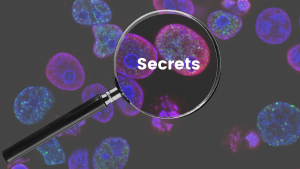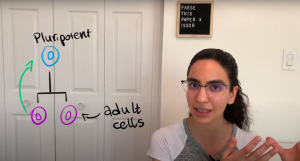Parmin Sedigh is a 15-year-old who is passionate about stem cells, developmental biology and science communication. She shares her love for the field by writing easy-to-understand articles on Medium and creating YouTube videos. She’s also the Director of Writing at Superposition, a non-profit focused on closing the gender gap in STEM, and is working on zebrafish regeneration with researchers at the University of Guelph. You can find her on LinkedIn or @ParminSedigh on Twitter.
“Stem cells can both self-renew indefinitely and differentiate into all other cell types in the body.” Yaaawn. That’s exactly what everyone in my high school science class thought the first time we learned about stem cells. But not me. I’d heard these words countless times, yet they never ceased to amaze me. They were like music to my ears, transporting me to a place of research and discovery. I’d known about these fascinating cells for a few months at that point: their endless applications, fascinating biology and controversial history being top of mind. Every single one of those topics interested me immensely. But where did this passion stem from (pun very much intended)?
In September 2020 I was 14 years old and attending high school in Kingston, Ontario, when I joined The Knowledge Society, or TKS for short. It’s a program that offers “Olympic-level training for innovators” and where I first learned about stem cells; more precisely, it was through what’s called an explore module, a series of videos and articles from around the internet teaching the basics of a science, technology, engineering and math (STEM) field. After doing several of these modules, the topic that most enticed me, day after day, month after month, and now one year later, was stem cells.
So why did it interest me? And why did I stick with it even though it meant having to spend dozens of gruelling hours reading papers I didn’t understand? (To be fair, those hours soon became much more enjoyable as I began to understand them.) I’ve been asked this question before, but every time I give a different answer. For instance, in a previous blog post where I attempted to tackle this question briefly, I mentioned that “I find [stem] cell biology fascinating” because they’re both the reason we’re alive and “also our downfall.” I’m not quite satisfied with that answer though so I’m here to answer this question once and for all. It may help you figure out if this is the right field for you and, if so, how you can get involved.
 First, to answer why I’m interested in stem cells: it’s a combination of two factors, the first of which is that I love discovering new things. It’s one of the reasons I find the work of an investigative reporter so fascinating. Getting to discover hidden secrets is quite literally the most interesting thing you could be doing (in my opinion, of course). Similarly, in stem cell science, you’re discovering the secrets that the cells have to offer. I like to think of stem cells as closed-off interviewees: you need to do a lot of work to break through their stubbornness to get a good story.
First, to answer why I’m interested in stem cells: it’s a combination of two factors, the first of which is that I love discovering new things. It’s one of the reasons I find the work of an investigative reporter so fascinating. Getting to discover hidden secrets is quite literally the most interesting thing you could be doing (in my opinion, of course). Similarly, in stem cell science, you’re discovering the secrets that the cells have to offer. I like to think of stem cells as closed-off interviewees: you need to do a lot of work to break through their stubbornness to get a good story.
One point worth mentioning, though it’s rather obvious, is that I’m not at a stage in my life where I’m revolutionizing the stem cell field. However, I get my dose of discovery through reading papers. I imagine my mind as a new world where these secrets aren’t yet discovered. Every paper I read is a new discovery made for this new world.
This first point helped me narrow down my own interests, but you can discover new things in lots of career paths. That’s not a good reason for choosing stem cell science specifically. That’s why there’s a second reason: this was a field that quenched my thirst for amazing cell biology yet to be discovered and offered so many applications that interested me so deeply. The applications aspect meant I could branch out from the basic science as well. But why am I even taking the time to tell you about this? It’s to give you an example of someone’s why—their reason for working day after day on a topic even though it may require lots of hard work.
Finding your “why”
You need a why to help you find a path you’re truly passionate about. If you don’t, it’s very easy to give up because you don’t see how all of the hard work you’re doing has value. If you have your why, everything becomes much more enjoyable.
With that out of the way, let’s discuss whether this is the right field for you. This is highly personal and involves a lot of self-reflection and self-awareness, both of which can be extremely difficult for a young person who hasn’t even lived for two decades. Here’s my biggest tip for figuring it out: explore many different fields on a fairly deep level. And these fields should vary starkly from one another so you can get a good sense of what you do—and don’t—like. But what does exploring actually mean? For me, this included watching some short videos and reading blog posts and articles. Sometimes I also watched lectures and read papers. Then, to consolidate my knowledge, I wrote blog posts or created videos.
To give you an idea of what this might look like, here’s what I did for my exploration…
- Data warehousing (storing and connecting all crucial business/company data in a single space): I did a fair bit of my own research and interviewed a CEO in the field to get more insight. Then I wrote a blog post on what I learned.
- Biocomputing & Quantum Mechanics (turning DNA into a mini computer; the explanation for how everything works at a subatomic level): Here, the only characters involved were me and my computer and, of course, long nights. The biocomputing blog post I wrote was rather superficial, but I felt like it was enough for me to check that field off as one where I wouldn’t want to spend the rest of my life. With quantum mechanics I dove in much deeper, and while I find this field fascinating, it is something I’d like to explore as a hobby rather than my main focus.
- Longevity (trying to extend the amount of time humans are healthy): This is where I took an even deeper dive. I read many papers and then created a YouTube video about what I’d learned.
- Stem Cells: Here, I also took the approach of a YouTube video. Then I took a short break to explore different topics. Yet as time went on, I slowly realized that the stem cell field had captured my heart and mind. As I did more in-depth research into induced pluripotent stem cells and embryonic stem cells and then wrote a blog post, I knew this was where I wanted to go.
But what happens once you find a general field that you enjoy? It’s time for even more exploration! Create some sort of map, like the one below, but with more details and fields, so you can then follow the map and find which subfield you’re interested in!
Forge your own path when exploring different fields or use my path as a guide, but whatever you do don’t restrict yourself to only similar fields.
Some practical advice on moving forward
Now we reach the last section: how to get involved in the stem cell field. This is where many stumble because after learning a bit, they have no place to apply their knowledge. I have three pieces of advice that you can practice from the comfort of your own home.
First is to create a portfolio of content. This could be blog posts, articles, videos, games, or any other medium that helps you both share what you’ve learned and consolidate your learning. The best way to identify gaps in your knowledge is to try teaching that topic to someone else, hence why this is such an effective method. After creating a portfolio, you’ll have something to show people when they ask why they should give you a chance. It makes it clear that you’re more than just words; you’ve done the work, and are ready to do more.
My next tip is to create a LinkedIn profile and use it regularly. Just do it. I can’t tell you how many opportunities I’ve gotten through LinkedIn, either through contacting experts on the platform or seeing posts about opportunities. Such as this one. The New York Stem Cell Foundation (NYSCF) began hosting an Immersive Experience for high school students when the pandemic began. It’s a one-week virtual “camp” where you get to learn about stem cell science and adjacent fields (like gene editing and ethics) by listening to talks and asking questions from experts, hearing about different careers in science, and even doing assignments on what you learn. I immediately applied and a few weeks later, got in! Now having finished the Immersive, I can tell you that it was an amazing experience and I have LinkedIn to thank.
As a bonus, here are a few LinkedIn pages you should follow to hear about the latest from the stem cell field: NYSCF, ISSCR, STEMCELL Technologies, Stem Cell Network, Harvard Stem Cell Institute and, of course, CCRM.
My final tip is to create opportunities for yourself. The stem cell field isn’t full of camps or programs for you to join, though this is a good place to start. Instead, take the time to create opportunities for yourself. Have you been following a company that you think could use some science communication work? Reach out and offer your services. Do you really want to work remotely at a lab? Learn to code in R (a programming language used in statistical analysis) and reach out, showing you have something valuable to add to their team. And the list goes on. Don’t be afraid to ask because the worst thing that could possibly happen is you don’t get a response or a you get a no. If it’s the former, you can follow up. Then you’re right back where you started, not any farther back. Actually, you may have taken a step forward because you’ve broken through your fear of rejection. If you get a no, move on to the next opportunity.
So to summarize, find your “why,” explore a variety of paths, create a portfolio, create a LinkedIn profile and follow pages relevant to your interests, and don’t wait around for opportunities to come to you—create them and ensure that you build some skills to add value to the team you want to join. Good luck!
Guest
Latest posts by Guest (see all)
- Regenerative immunotherapy: Hope for chronic autoimmune diseases - September 16, 2025
- Canada’s regenerative revolution: Why AI is the catalyst - September 4, 2025
- Summer by Design: A launchpad for future entrepreneurs and industry scientists - August 14, 2025








Loved reading this! Your passion for stem cells really shows, and the way you broke down your journey was super inspiring and easy to follow. Great tips too!
Thanks for that comment. Parmin Sedigh is indeed passionate about stem cells and the field. She’s one to watch!
You can catch up with her progress here: https://www.signalsblog.ca/three-years-ago/